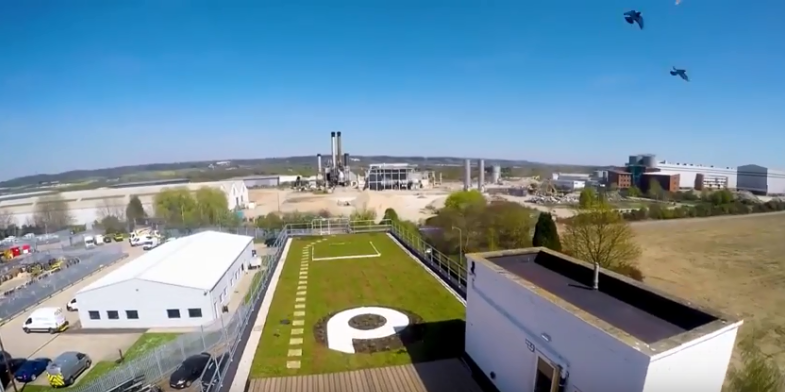Permavoid 85/150
Permavoid 85 and 150 - Product Codes: PVPP85 and PVPP150 Permavoid units are available in two depths, 85mm and 150mm. Both are used to create a g

It is no secret that the biggest challenge facing the UK public sector over the next generation will be how it can adapt to serve an increasingly ageing population. The UK has crept into a situation whereby there are more people over the age of 65 than under the age of 16, writes Sean Robinson of Polypipe.
Furthermore, with more of the UK population moving into the larger cities as urbanisation continues apace, town and city councils also need to deal with the by-products of this change in demographics as concern grows over the health and wellbeing of individuals, and the balance of biodiversity in our inner cities.
Air pollution, climate change, urban flooding and even mental health issues are some of the many effects that can be attributed to the built environment. Recent news reports demonstrate that the most vulnerable groups are children, the elderly or those with pre-existing medical conditions – those who rely most on public services and public sector accommodation. In the UK alone, poor outdoor air quality is linked to 50,000 deaths each year.
However, specifiers are increasingly turning to a range of forward-looking solutions and new building specialisms that will define new approaches to public sector construction and the way UK citizens will interact with their municipal-managed buildings. The use of green infrastructure is one example of how long-discussed building practices are now becoming a project necessity, rather than a ‘nice to have’ or a ‘value add’ only considered if the budget allows for it.
Essentially, green infrastructure is the preservation and development of natural spaces in urban areas. Parks, roof gardens and even cycle lanes can be considered part of the green infrastructure concept. They all represent elements of the natural world integrating with the urban environment.
Planners, architects, civil engineers and developers in the UK are beginning to harness green infrastructure’s true potential. After decades of concrete, we are starting to see the next generation of green living emerge.
More major cities are placing greater emphasis on the development and preservation of green spaces within our urban centres – not only because of health benefits – but because of the boost it can bring to the economy.
For example, Manchester City Council’s Green and Blue Strategy states that: “By 2025, high-quality, well-maintained green and blue spaces will be an integral part of its neighbourhoods.”
The report adds: “Businesses will be investing in areas with high environmental quality and attractive surroundings, and will have a healthy, talented workforce to draw on. There will be new ways of funding green and blue infrastructure, making sure that we can sustain the progress made by 2025, providing the platform for investment in the years to follow.”
Other cities are following suit. Birmingham, Leeds, Cardiff, Edinburgh and Belfast have also committed to increasing green and blue spaces in the coming years. These grand visions of greener cities will have to be driven by municipal bodies.
There are schemes in the UK where green infrastructure solutions have been designed as an integral part of the project. The proposed redevelopment of the Thamesmead in South-East London will turn the borough of Thamesmead into one of the city’s most biodiverse and sustainable urban living environments. This large-scale redevelopment of one the biggest post-War residential schemes will serve more than 100,000 people living in 35,000 homes on the banks of the Thames.
Developing new house-building with the intelligent use of water at the heart of the design is not just about aesthetics and the environment. Once you dig deeper into these city-wide initiatives, there are examples of how green infrastructure works on a very practical level to assist with the care and comfort of some of our most vulnerable people.
In the UK there are currently 850,000 people living with the condition, with a predicted rise to one million people by 2025 – a result of our ageing population. Loughborough University and the Building Research Establishment (BRE) have teamed up to design and build an experimental home in Watford that will better support those living with dementia.
Among the design features of the typical Victorian-era house, such as increased natural lighting and automatically controlled natural ventilation systems, a range of green infrastructure features have been included. Polypipe Permavoid has been installed to provide passive irrigation and to aid establishment and support the fragrant plants and herbs around the paving area of the home, as research has shown how sensory stimulation including touch and smell can maintain the attention of the dementia sufferer.
The Permavoid system also incorporates stormwater management to the solution to prevent a build-up of surface water following rainfall. Providing multifunctional benefits from one solution.
A range of demographic changes are challenging the ways urban planners, architects and specifiers approach large-scale developments. The need to build municipal areas that can cope with the growing numbers of city dwellers and an ageing population is challenging building design norms, and providing the scope to embrace forward-thinking intelligent design. Building designers are increasingly incorporating biophilia – meaning the love of nature – into our towns and cities.
Permavoid 85 and 150 - Product Codes: PVPP85 and PVPP150 Permavoid units are available in two depths, 85mm and 150mm. Both are used to create a g